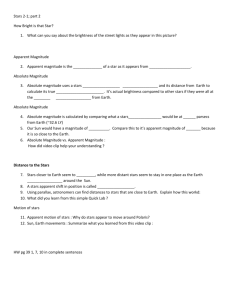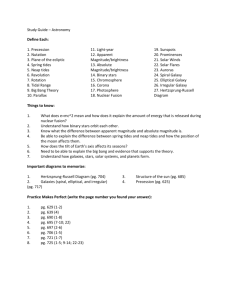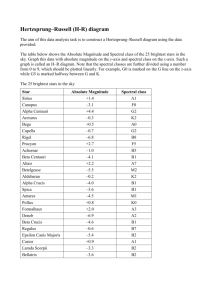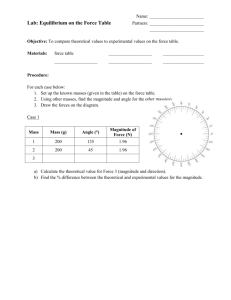aas_sproul - Widener University
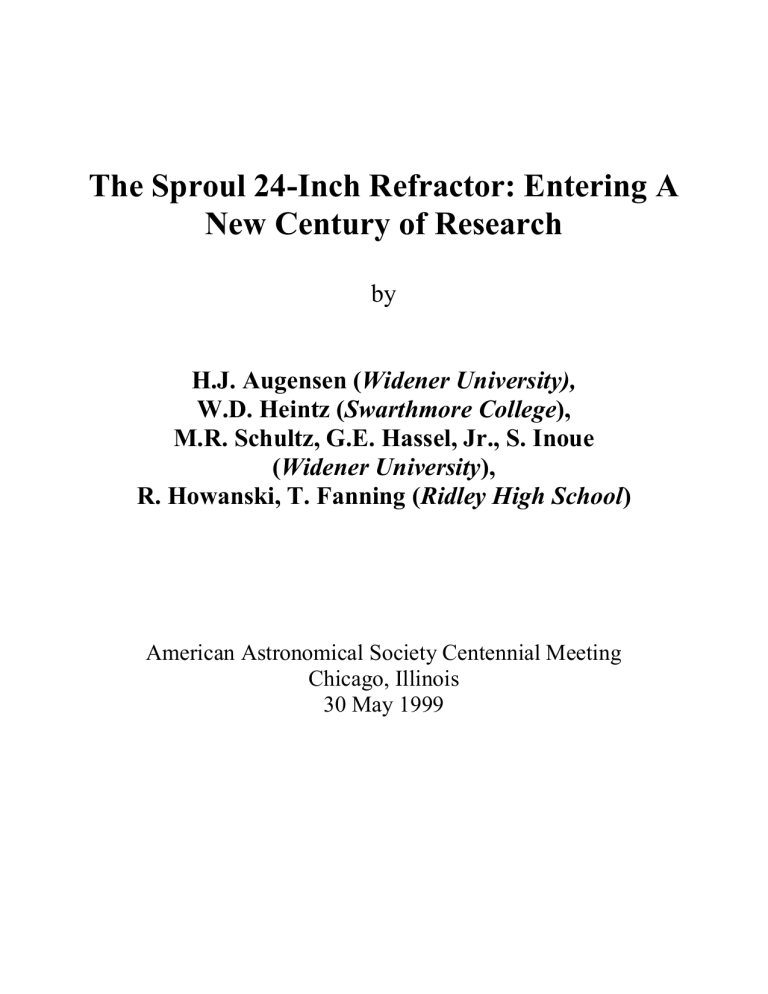
The Sproul 24-Inch Refractor: Entering A
New Century of Research
by
H.J. Augensen (Widener University),
W.D. Heintz (Swarthmore College),
M.R. Schultz, G.E. Hassel, Jr., S. Inoue
(Widener University),
R. Howanski, T. Fanning (Ridley High School)
American Astronomical Society Centennial Meeting
Chicago, Illinois
30 May 1999
ABSTRACT
The Sproul Observatory, located in Swarthmore, Pennsylvania, has been in operation since 1912. Its major research instrument is a 24-inch, f/18 refracting telescope with lenses made by Brashear. The research conducted during the 20th century concentrated on obtaining parallaxes of nearby stars and also on the exploration of visual double and multiple star systems. The
Sproul plate vault contains some 90,000 plates, from which 1500 stellar parallaxes, or about 10% of the current parallax database, have been extracted.
Heintz made 54,000 observations (including those made with other telescopes) of double stars over 43 years (47,500 by micrometer, 6500 by photography), resulting in the calculation of 500 orbits and 900 newly discovered double stars. Photographic observations ceased in 1994. In 1998 the refractor was fitted with an Apogee AP-6 CCD camera, which contains a
Kodak KAF 1000 chip with 1024 x 1024 pixel array, and gives a 0.45 arc seconds per pixel image scale and 8 x 8 arc minute field of view at the focal plane. The camera is operated using PMIS software. A filter wheel constructed by ISI Systems and attached to the camera contains 5-mm thick B,
V, and R filters. The Sproul telescope has now been given a new task: the study of variable stars. Currently under investigation are RV Tauri and semiregular variables, SX Phoenicis stars, and also stars which are suspected of being variable, taken from the New Catalogue of Stars Suspected of
Variability of Light , Nauka Publishing, Moscow 1982. Thus far, the most convincing cases for variability are NSV 656 (irregular?), 1098 (large amplitude, probably Mira type), 1470 (short P, eclipsing?), and 13514
(P~105d?). This work has been supported by a Provost Grant from
Swarthmore College, by a Faculty Development Grant from Widener
University, and by the Howard Hughes Medical Institute-Supported Summer
Research in Science Program.
BRIEF HISTORY
1869 Susan J. Cunningham becomes first Professor of
Mathematics & Astronomy, retires in 1906
1907 William Cameron Sproul expresses intention to provide funds for a large astronomical observatory on campus of
Swarthmore College, construction begins 1910
1912 Sproul refractor begins continuous operation in
January
1929-36 John Anthony Miller becomes first Director of
Sproul Observatory, having previously served as Professor of
Mathematics & Astronomy since 1906
1937 Peter van de Kamp appointed Professor of Astronomy and Director, serves until 1972
1966-7 refractor overhauled for 7 months, tracking & setting motors installed, also new electronic console
1971 Grant two-coordinate measuring machine installed
1972 Sara Lee Lippincott appointed new Director, succeeded by John Hershey in 1980 and John Gaustad in 1982
1994 Photographic program terminated, micrometer observations ceased in 1998
1998 Apogee AP-6 CCD camera attached to refractor in
March
THE SPROUL 24-INCH REFRACTOR
aperture 0.61 m
focal length 11 m
focal ratio f/18
lenses made by John A. Brashear Co.
ideal for precise measurement of positions & motions of stars
not much affected by background campus & suburban lighting
PAST RESEARCH PROJECTS
Photographic Observations
used to determine distances of stars, especially nearby faint dwarfs
Sproul plate archive contains probably largest astrometric plate collection from one telescope:
90,000 photographic plates obtained by faculty, staff, & students since 1912
1500 parallax determinations (~ 10% of current parallax database)
Micrometer Observations
micrometer observations of visual binary stars, their orbits & masses
visual observations, mainly by W.D. Heintz since 1967:
500 binary star orbits
900 newly discovered binaries
study of low-mass binaries
THE APOGEE AP-6 CAMERA
Kodak KAF 1000 Chip
1024 x 1024 pixel array, 24
square pixels
total surface area of chip 24.6 mm x 24.6 mm square
front-illuminated, no antiblooming
thermoelectrically cooled
AP-6 Camera Mounted on 24-Inch
field of view 8
x 8
pixel scale 0.45
per pixel at focal plane
16-bit images, ~ 2 Mb each
camera operated by PMIS software, full version
filter wheel by ISI Systems, with standard B, V, R filters from
Omega Optical
NEW RESEARCH PROJECTS: STUDY OF VARIABLE
STARS
Long Period & Unusual Variables
RV Tauri and Semiregular Variables
Mira-type Variables
Suspected Variables
Short Period Variables
SX Phoenicis Variables
Visual Binaries
SUSPECT STARS WHICH EXHIBIT VARIABILITY
(from New Catalogue of Stars Suspected of Variability of Light, Nauka
Publ., Moscow 1982)
Plots of V magnitude (or R magnitude) of the target star relative to a comparison star, usually indicated by T-C in the legend, versus Julian Date for several suspected variables. In nearly all cases, the R magnitude plot is similar. If two comparison stars were available in the field, then the difference in magnitudes between comparison stars is also plotted to show the size of the random error.
All processing has been done using IRAF (Image Reduction and
Analysis Facility), with instrumental magnitudes obtained using the imexamine feature of the apphot package within IRAF.
NSV 656 (BD +36
341)
Variation in relative V magnitude observed over 1998 October 22 through 1999 January 15, showing a definite variation in brightness of range ~1 magnitude during the interval covered. Its magnitude is listed as mpg ~ 11 to 11.5 (Sonneberg), and its spectral type is listed as M. More data over a larger baseline is needed, but it is possibly an irregular variable.
NSV 1098 (BD +70
236)
Variation in relative V magnitude observed over 1998 October 23 through 1999 January 10, showing a steady decrease in brightness of about 3 magnitudes during this period. Its magnitude is listed as mpg ~ 13.5 to 15.5 (Johnson et al.), and its spectral type as M4. More data over a larger baseline are needed, but the large amplitude variability over nearly three months suggests that it may be classed tentatively as a Mira-type variable with a period in excess of 480 days.
NSV 1470
Variation in relative R magnitude observed over 1998 November
23 through 1999 February 14, showing erratic light variations, almost certainly on a much shorter time frame than the spacing between successive observations. Its magnitude is listed as mpg ~
11.8 to 12.5 (Bamberg), and no spectral type given. The appearance of these variations suggest that more frequent coverage is needed to make a more definitive curve. This object may be a short-period eclipsing binary.
NSV 13514
Variation in relative V magnitude observed over 1998 July 21 through December 2, showing a periodicity of P ~ 105 d.
Additionally, the two maxima display different heights. Its magnitude is listed as mpg ~ 10.5 to 11.4 (Bamberg). A second comparison star was added in October, and so the difference between the two comparison stars is plotted in the lower part of the graph beginning around JD 2451100.
NSV 14159
Variation in relative R magnitude observed over 1998 July 21 through December 2. There is a significant gap of over 30 days in the observations in the first half of the graph, where a maximum may have occurred. If so, then the period is ~ 70 d. The random error as indicated by the relative magnitude of the comparison stars is rather large, on the order of
0.07 mag. The photographic magnitude of this object is listed as mpg ~ 11.6 to
12.6. Further observations taken at regular intervals of less than one week are needed.
CY Aquarii
Variation in relative V magnitude observed on night of 1998
August 3. This is an 11th magnitude SX Phoenicis-type star with an amplitude of about 0.8 magnitudes and a period of 88 min.
CAPTIONS FOR POSTER
Fig. 1. The Sproul Observatory
Fig. 2. The 24-inch Sproul Refractor with AP-6 Camera attached
Fig. 3. The AP-6 Camera (blue) and filter wheel (just above)
BROCHURES
The Sproul Observatory of Swarthmore College
(Please do not take from this display)
ACKNOWLEDGEMENTS
The authors are grateful for support for this work by a Provost
Grant from Swarthmore College, by a Faculty Development
Grant from Widener University, and by the Howard Hughes
Medical Institute-Supported Summer Research in Science
Program at Swarthmore College. We also wish to thank Dr.
Brian Martin, Dr. Larry Marschall, Dr. Dennis Dawson, and Mr.
Wayne Brown for guidance in the planning and implementation of the new research program.
